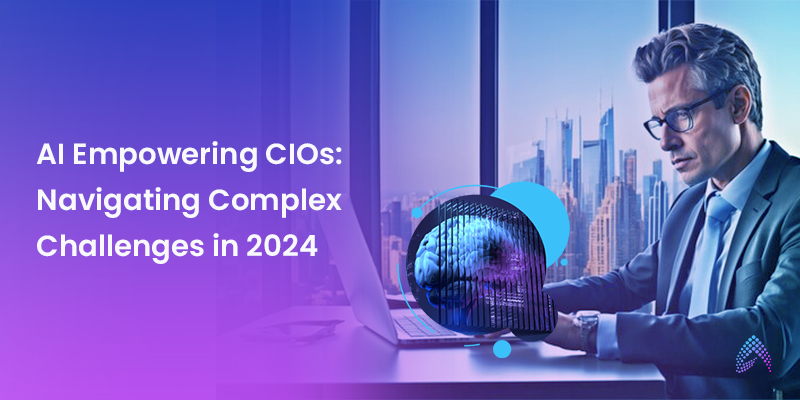
From integrating emerging technologies to managing cybersecurity threats and driving operational efficiencies, the role of a CIO has never been more complex or crucial. As organizations increasingly rely on technology to fuel their growth and operations, the demands on CIOs to deliver cutting-edge solutions while ensuring seamless and secure IT operations have intensified.
Enter artificial intelligence (AI), a transformative force poised to reshape how CIOs tackle these multifaceted challenges. AI offers powerful solutions to automate complex processes, enhance decision-making with predictive analytics, and streamline IT operations.
7 CIO Challenges In 2024:
1 . Cybersecurity:
When cybersecurity takes a backseat, the ripple effects can be far-reaching and hard-hitting. Picture this: a data breach not only shatters customer trust and loyalty—both incredibly tough and costly to rebuild—but it also strips your company of the chance to stand out as a secure and reliable choice in a market that’s putting a premium on data protection.
For CIOs, AI is a potential ally to combat cyber security threats. AI technologies such as Machine Learning and Natural Language Processing understand and automate tedious tasks like threat detection and incident response, freeing up security analysts to focus on strategic initiatives and complex investigations.
Example:
In response to increasing cybersecurity threats, IBM has leveraged AI in its QRadar Advisor with Watson. This system analyzes and interprets security data, including unstructured texts, to provide faster and more accurate threat detection and response.
2. Data Management and Analysis:
Without tapping into this treasure trove effectively, you’re missing out on optimizing operations and tailoring our strategies to meet real customer needs— essentially leaving money on the table. And let’s not forget about market trends; failing to spot and adapt to these because you’re not effectively interpreting your data could leave you behind the competition.
Machine Learning, a branch of AI technology, can be used to automate the tedious tasks of cleansing and integrating data, ensuring accuracy for reliable analysis. It also automates data discovery and classification, saving valuable time and resources by automatically identifying and labeling data sets for easier management and retrieval.
Example:
Netflix leverages AI to analyze viewer data, enabling it to personalize content recommendations and inform content creation decisions. This data-driven approach helps Netflix maintain high engagement rates and subscriber growth.
3. Digital Transformation:
When it comes to digital transformation, dragging your feet can set you back. Think about it: if you’re slow to adopt the latest digital tools and technologies, you’re not just running the risk of inefficient operations—you’re potentially alienating a modern, tech-savvy customer base that expects slick, seamless interactions.
By facilitating smarter resource management, optimizing operations, and enabling a more responsive customer service framework, AI not only supports but accelerates the digital transformation journey, making enterprises more agile, innovative, and equipped to meet the challenges of the digital age.
Example:
Pfizer has successfully harnessed the power of IBM Watson, an advanced AI platform, to revolutionize its drug discovery and research processes. Watson’s cutting-edge capabilities in deep learning and natural language processing enable it to analyze vast amounts of scientific data and research rapidly. By seamlessly integrating AI, Pfizer accelerates research, slashes costs, and substantially increases the likelihood of breakthrough treatments.
4. IT Infrastructure Management
On the IT front, if your infrastructure management is stuck in the past, you’re not just dealing with system downtimes; you’re also wasting human and financial resources to maintain outdated systems. Additionally, if you don’t keep up with the latest tech, you’re missing out on serious performance boosts that could streamline your entire operation.
By harnessing the power of AI, companies can tap into historical data to foresee equipment failures before they cause havoc, ensuring operations run smoothly without costly interruptions. More than just a monitoring tool, AI acts as a vigilant guardian, operating around the clock to detect threats early and shore up vulnerabilities.
Example:
Google uses its DeepMind AI to manage power usage in data centers, improving cooling efficiency by 40% and overall energy usage by 15%, showcasing significant cost savings and environmental benefits.
5. Innovation and Competitive Advantage:
Failing to innovate means missing out on defining market trends, attracting top talent, and capturing new market segments. And when the industry inevitably shifts, a lack of innovation leaves you scrambling instead of smoothly adapting. Ultimately, this isn’t just about losing a competitive edge; it’s about stunting your company’s growth in the long haul.
Despite a rich history of innovations and technology frameworks, many business leaders still need help to develop robust innovation methods.
By leveraging AI and deep insights, CIOs can anticipate trends and proactively adapt emerging technologies and their potential applications. This environment encourages and fosters a culture of innovation and leads to the development of groundbreaking solutions.
Example:
Tesla’s Autopilot system continuously improves through machine learning, analyzing vast amounts of driving data to enhance vehicle safety and performance, showcasing how AI drives innovation and competitive advantage.
6. Business Continuity:
If you can’t keep things running smoothly during tough times, don’t be surprised if your customers start looking elsewhere, to competitors who’ve got their act together. This unpreparedness can lead to significant operational, financial, and reputational damage, making it difficult to regain your footing in a competitive market.
AI technology enhances business continuity by automating data backups and disaster recovery processes, ensuring minimal downtime and data loss. AI helps businesses maintain operational resilience under adverse conditions by providing real-time analysis and rapid response capabilities.
Example:
Walmart leverages AI’s predictive analytics capabilities to dynamically adjust its inventory and supply chain operations, ensuring that products are available where and when customers need them, even in the face of supply chain disruptions.
7. Compliance and Regulatory Changes:
Companies that are proactive about compliance can set themselves apart in sectors where trust is everything. This isn’t just about following rules—it’s about showing your customers and competitors that you’re reliable and serious about doing things right.
AI’s predictive capabilities swiftly adapt to changing regulations and identify potential compliance risks before they escalate. This proactive approach not only saves time but also reduces the risk of penalties and enhances trust with stakeholders.
Example:
JPMorgan Chase & Co. implemented an AI program, COiN (Contract Intelligence), which processes and extracts important data from documents in seconds, a task that previously consumed 360,000 hours of work each year, aiding compliance efforts.
Conclusion
By leveraging AI technology, organizations can gain greater visibility and efficiency across their processes. However, simply adopting AI solutions because it’s a trend won’t necessarily lead to success and a positive return on investment. Instead, businesses should consider custom AI solutions and strategies tailored to their specific needs to unlock the full potential of AI technology. Doing so can also create new opportunities for generating revenue.
Learn more about how to build a custom AI strategy for your business.

Author: Ganna V
President & CEO – Growth Markets
Driving strategic growth initiatives, fostering innovation, and leading high-performing teams for impactful business expansion.



